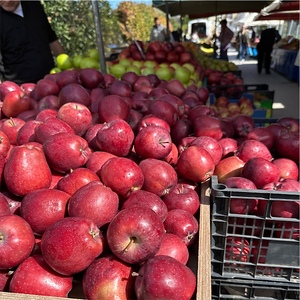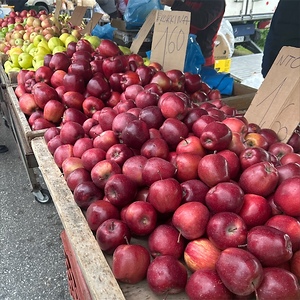


Zagorin Apples
Estimated Inventory, lb : 0
Description/Taste
Zagorin apples are the label given to apples native to Zagora, Greece. The many varieties under this label encompass a multitude of colors, shapes, and flavors. They range from medium to large in size and can have conical, round, globular, and flattened shapes. Their skin can vary from thin to thick and may be yellow-orange, red-striped, red-pink, yellow-green, and greenish-red. Their color is sometimes dependent on the amount of sun exposure they get. Zagorin apples typically have a firm, crisp texture that ranges from white to yellow. These juicy, aromatic fruits possess a range of flavors from sweet to slightly sour.
Seasons/Availability
Zagorin apples are generally harvested from August to October and can be stored until early summer.
Current Facts
The botanical name for Zagorin apples is Malus domestica and they are from the Rosaceae family. Rather than referring to a specific cultivar, "Zagorin apples" is the label given to the many varieties produced by the Agricultural Cooperative of Zagora-Pilio, each marked with a "Zagorin" sticker. Some of these varieties include Starking Delicious, Royal Gala, Fuji, Reinette Du Canada, and Fyriki of Pelion. These fruits are distributed by the Agricultural Cooperative of Zagora-Pilio. Established in 1916, this is one of the oldest cooperatives in Greece. They produce high-quality apples that have been designated by the European Union as a protected origin product since 1996. This title is given to certify that a product is only cultivated in a specific geographic area, like gorgonzola and prosciutto from Italy or champagne from France.
Nutritional Value
Apples are mostly carbohydrates and water. They contain simple sugars like glucose, fructose, and sucrose along with fiber, vitamin C, potassium, and other antioxidants. Fiber maintains a healthy digestive system and lowers blood sugar levels, potassium contributes to heart health, and antioxidants are anti-inflammatory and anti-viral.
Applications
Zagorin apples can be consumed fresh, cooked, or dried. In their fresh form, they may be eaten as a snack, used to make caramel apples, or tossed into salads, fruit bowls, granola, and oatmeal. They bode well for baked goods like apple cake, cinnamon bread, strudel, pie, cobblers, and tarts. Zagorin apples may be incorporated into drinks like sangria, cider, mulled wine, and apple martinis. They are mixed into stuffings, soups, apple sauces, and harvest bowls. This variety can be used to make apple sausage or sautéed with spices to pair with pork chops. Zagorin apples are complemented by ingredients like brown sugar, butternut squash, cranberries, Brussels sprouts, celery, walnuts, grapes, lettuce, spinach, butterscotch, dill, cabbage, pecans, almonds, blue cheese, rhubarb, strawberries, bananas, ice cream, quinoa, goat cheese, peanut butter, nutmeg, rosemary, and thyme. They may keep for up to 9 months when stored in a refrigerator or another cool, dry place.
Ethnic/Cultural Info
The village of Zagora, Greece, where Zagorin apples originate, has historically depended on farming for its survival. When the Agricultural Cooperative of Zagora was developed, much of its production was centered around potatoes, chestnuts, and hazelnuts. The first apple variety produced by the cooperative was the Starking Apples, a variety that makes up almost all of Zagorin apple production today. The apples of these regions are still celebrated in this village during the Apple Festival. At this event, hundreds of visitors sample free varieties of Zagorin apples while learning about different recipes and the history of each cultivar.
Geography/History
The Agricultural Cooperative of Zagora-Pilio was first created in 1916 in the town of Zagora in Thessaly, Greece. In the mid-20th century, apples were introduced into the cooperative and they soon started cultivating different varieties. The introduction of this fruit enabled the Cooperative to expand into major markets in Athens and Thessaloniki, Greece, and eventually 24 other countries across the European Union, the Middle East, and the Persian Gulf. By 1985, the Zagorin brand was created and all apples began to be sealed with this name. Zagorin apples grow best in temperate climates with cool winters, mild springs, warm summers, and consistent moisture—all of which their native Greece possesses. These varieties have grown greatly since they were first cultivated and are now sold in stores all over the world. They cannot be grown in home gardens as they are a protected product that is only produced commercially under the Zagorin label.
Recipe Ideas
Recipes that include Zagorin Apples. One
| Test Driver |
|
Turkey Stuffed with Apples and Nuts |









